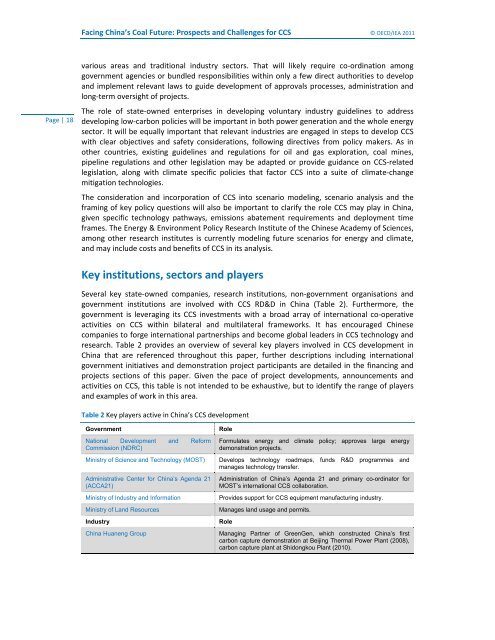Facing China's Coal Future - IEA
Facing China's Coal Future - IEA
Facing China's Coal Future - IEA
You also want an ePaper? Increase the reach of your titles
YUMPU automatically turns print PDFs into web optimized ePapers that Google loves.
<strong>Facing</strong> China’s <strong>Coal</strong> <strong>Future</strong>: Prospects and Challenges for CCS © OECD/<strong>IEA</strong> 2011<br />
Page | 18<br />
various areas and traditional industry sectors. That will likely require co‐ordination among<br />
government agencies or bundled responsibilities within only a few direct authorities to develop<br />
and implement relevant laws to guide development of approvals processes, administration and<br />
long‐term oversight of projects.<br />
The role of state‐owned enterprises in developing voluntary industry guidelines to address<br />
developing low‐carbon policies will be important in both power generation and the whole energy<br />
sector. It will be equally important that relevant industries are engaged in steps to develop CCS<br />
with clear objectives and safety considerations, following directives from policy makers. As in<br />
other countries, existing guidelines and regulations for oil and gas exploration, coal mines,<br />
pipeline regulations and other legislation may be adapted or provide guidance on CCS‐related<br />
legislation, along with climate specific policies that factor CCS into a suite of climate‐change<br />
mitigation technologies.<br />
The consideration and incorporation of CCS into scenario modeling, scenario analysis and the<br />
framing of key policy questions will also be important to clarify the role CCS may play in China,<br />
given specific technology pathways, emissions abatement requirements and deployment time<br />
frames. The Energy & Environment Policy Research Institute of the Chinese Academy of Sciences,<br />
among other research institutes is currently modeling future scenarios for energy and climate,<br />
and may include costs and benefits of CCS in its analysis.<br />
Key institutions, sectors and players<br />
Several key state‐owned companies, research institutions, non‐government organisations and<br />
government institutions are involved with CCS RD&D in China (Table 2). Furthermore, the<br />
government is leveraging its CCS investments with a broad array of international co‐operative<br />
activities on CCS within bilateral and multilateral frameworks. It has encouraged Chinese<br />
companies to forge international partnerships and become global leaders in CCS technology and<br />
research. Table 2 provides an overview of several key players involved in CCS development in<br />
China that are referenced throughout this paper, further descriptions including international<br />
government initiatives and demonstration project participants are detailed in the financing and<br />
projects sections of this paper. Given the pace of project developments, announcements and<br />
activities on CCS, this table is not intended to be exhaustive, but to identify the range of players<br />
and examples of work in this area.<br />
Table 2 Key players active in China’s CCS development<br />
Government<br />
National Development and Reform<br />
Commission (NDRC)<br />
Ministry of Science and Technology (MOST)<br />
Administrative Center for China’s Agenda 21<br />
(ACCA21)<br />
Ministry of Industry and Information<br />
Ministry of Land Resources<br />
Industry<br />
China Huaneng Group<br />
Role<br />
Formulates energy and climate policy; approves large energy<br />
demonstration projects.<br />
Develops technology roadmaps, funds R&D programmes and<br />
manages technology transfer.<br />
Administration of China’s Agenda 21 and primary co-ordinator for<br />
MOST’s international CCS collaboration.<br />
Provides support for CCS equipment manufacturing industry.<br />
Manages land usage and permits.<br />
Role<br />
Managing Partner of GreenGen, which constructed China’s first<br />
carbon capture demonstration at Beijing Thermal Power Plant (2008),<br />
carbon capture plant at Shidongkou Plant (2010).
















